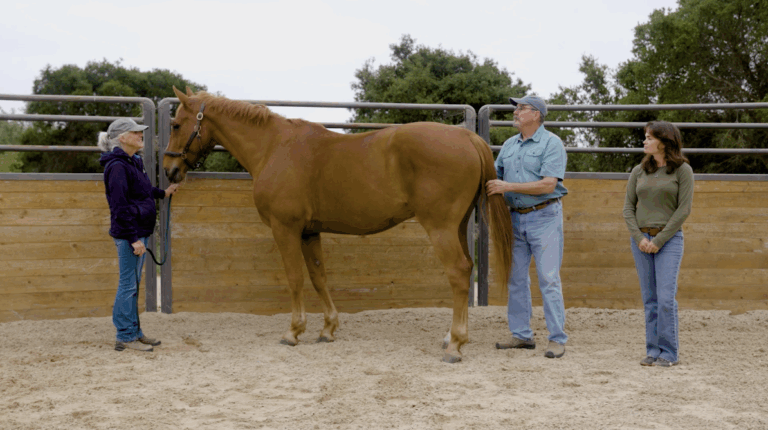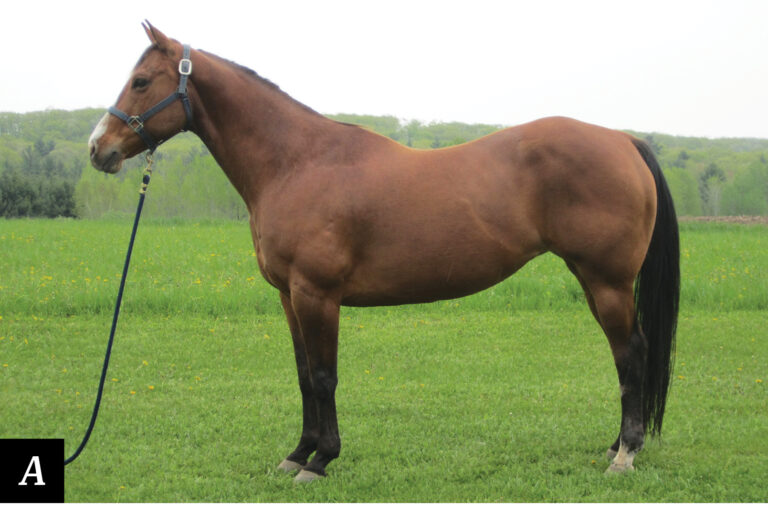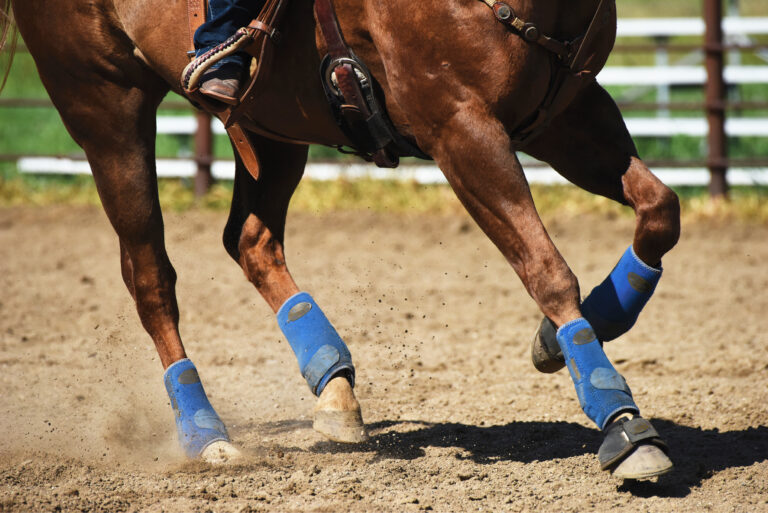When you’re at home, consistent grooming helps keep your horse’s coat looking sleek, healthy, and shiny. At the show, those same habits come in handy for a different purpose all together. When you and your horse look neat, clean, and professional, you’re presenting the absolute best version of yourselves to the judge long before you start your pattern or turn to follow the rail.
Products we feature have been selected by our editorial staff. If you make a purchase using the links included, we may earn a commission. For more information click here.
[READ: 9 TIPS FOR SHOW-RING SHINE]
The way you look in the show pen can be just as important as the way you perform, according to Wendy Huss of Scottsdale, Arizona-based Huss Performance Horses.
“In my experience, it makes a difference to the judge when someone comes into the pen and they’re really turned out well,” Wendy says. “My theory is that so much can happen when you go through that gate, whether you’re running a reiner in or riding a pleasure horse down the rail, that you should control everything you can before you enter the pen. And that includes how you present yourself and your horse. You only have one chance to make a good impression. To do otherwise is a disrespect not only to the judge, but yourself, because you represent yourself and your trainer.”
Dan and Wendy Huss train and show reining horses at Smoking Roosters Ranch, and whether she’s grooming a horse for a non-pro class or to enter the pen at the World Equestrian Games, Wendy says it’s all about the details.
“When our horses go into the reining pen, they’re pretty close to how they’d look going into a showmanship class. We’re pretty serious about making sure every horse is clipped, oiled, and sprayed,” Wendy says.
Adding an extra layer of shine to an already spotlessly groomed horse is part of trainer Keith McDonough’s pre-show grooming routine as well, and with good reason. Along with business partner Mark Jensen, Keith trains and shows all-around horses at Palm Desert Quarter Horses in Palm Desert, California. With years of experience turning out horses for the show pen, Keith knows the value of making the best first impression possible.
“The importance of having your horse impeccably groomed is you only have one chance to make a first impression,” Keith explains. “It’s vital to make a good impression on the judge by catching his or her eye in a positive manner the first time you enter the ring.”
Tools of the Trade
The first step to keeping your horse looking his best is stocking your grooming kit with the right tools. From brushes and clippers to oils, sprays, and chalks, find the products that work best for your horses and your program. For Wendy, curry combs and electric horse vacuums are ideal for everyday use.
“Our daily practice isn’t that much different than what happens at the horse show,” Wendy says. “We curry every horse all over and use vacuums every day.”
Brushes. Stock your kit with rubber curry combs, body brushes, soft brushes, hoof picks, and towels. If you travel often, designate one kit for your trailer and one for your barn.
Clippers. For legs, bridle paths, ears, and whiskers invest in the best pair of clippers you can afford, and maintain them on a regular basis. Oil and sharpen clipper blades for best results.
Need new clippers? We found some options on Amazon for you; Wahl Show Plus or Oster cordless clippers.
“Before every show, we clip our white legs with a #40 blade,” Keith says. “It’s a close clip, but it means that white legs look nice and clean without an added product like cornstarch.”
Vacuums. Electric equine grooming vacuums can be a lifesaver at home or at the show, especially if you invest in a smaller model that’s easier to haul. Before using a vacuum for the first time, take care to desensitize your horse to noise and suction.
“Our vacuum has two motors, so when we’re just starting out, we’ll start with just one motor so the suction isn’t so hard,” Wendy says. “Generally speaking, it’s like a massage for the horses. They learn to love it.”
Mane and tail products. Leave-in conditioners and serums help keep manes and tails silky and tangle-free.
Try these mane and tail products; Cowboy Magic, Mane ‘n Tail Detangler, ShowSheen, or UltraCruz.
Oils, sprays, and chalks. Finishing oils and sprays give even the shiniest coat an extra layer of gloss. For all-around horses, black spray, chalk, and black hoof polish add a finishing touch to hooves.
[READ: MAKE YOUR HORSE SHINE]
Wendy likes to use white livestock chalk to keep white faces and markings extra bright.
“I’ll use a #10 blade to clip blazes or bald faces, and then scribble the white chalk over the markings,” Wendy says. “Then you can use some of the face oil on your hand to get rid of the excess powder and stay in the lines.”
Glow BEFORE YOU SHOW
The way your horse looks in the show pen starts months before you ever set foot on the facility grounds. The keys to keeping your horse’s coat healthy and shiny are good nutrition and horsekeeping habits.
“We ask our show horses for a lot, but they’re also cared for really well,” Wendy says. “It’s like a spa day every day. We have a host of equine professionals who help us do what we do, including a nutritionist, dentist, and blacksmith.”
Supplements. At Palm Desert Quarter Horses, the horses are fed supplements for hair and hoof growth.
“We feed straight biotin as a supplement to make their feet grow faster, so they’re always producing healthy feet,” Keith says. “Currently, the California-grown hay we feed is so high in starch and sugar that our vet has told us to just feed ‘diet grain’ formulated for ponies and miniature horses. We are also feeding Equine Mega-Omega oil for their coats and joints. The horses get an ounce of oil on their feed every day and that really helps with their coats.”
Dan and Wendy rely on special vitamin blends developed by Caron Haggerty of Equine Health and Performance, an equine vitamin and supplement company in Spring Hill, Tennessee.
“Caron has products for everything, including hoof growth and haircoats, that are all raw, organic, and freshly made,” Wendy says. “It’s not inexpensive, but it’s the best money spent. If your horse feels good from the inside out, he’s likely to be easier to train. And we’ve encountered fewer vet bills.”
Lights. Keeping show horses indoors cuts down on sunburned skin and bleached haircoats, but another trick for maintaining a sleek coat is to keep the lights on for 16 hours each day.
“All our horses are under lights from 5 a.m. until 11 p.m.,” Keith says. “It simulates that many hours of daylight for the horse and keeps them from getting long coats.”
Clipping. By regularly clipping legs, faces, ears, and bridle paths, it’s easier to keep the horses neat and clean for the show pen.
“We clip our horses’ legs like a showmanship or pleasure leg because when the hair is shorter, we don’t have as much trouble with scratches and fungus,” Wendy explains.
Purchase a pair of Wahl Show Plus or Oster cordless clippers!
Spa day. Just like with human hair, product buildup from shampoos, conditioners, and fly spray can make even healthy horse hair look dull.
“Our facility has a fly system, which means the horses are getting chemicals sprayed on them all the time, so we like to do hot oil treatments once a month,” Wendy shares. “I put a little bit of hot oil in warm water, and then upend the bucket right behind the ears and dump it all the way down their back. Then we let the horses drip-dry. It helps to condition their skin and keeps their haircoats looking nice. If you plan to ride outside or turn your horse out, make sure to rinse it off to avoid sunburn.”
Even the littlest details matter. “This comes from my showmanship and pleasure days, but I like to put hoof oil on my horses’ chestnuts and keep them peeled. So many people don’t pay attention to those, but it’s an important little detail,” Wendy says.
From MANE TO TAIL
How to dress manes, tails, and forelocks varies from discipline to discipline, but keeping long manes and tails healthy depends on how you treat them at home.
“At home, we don’t like for our grooms to comb the manes and tails every day, because then you end up with no mane and tail,” Wendy explains. “The tails are usually up in a knot to keep them protected. During schooling and just before a class, we’ll put the manes in four big bands to keep them from getting snarled up in the reins. Then when the horse is up to show, we take the bands out during our final go-over.”
Mane events. For reiners, loose, natural manes are usually the order of the day, while Keith’s all-around, trail, and Western pleasure horses get banded regularly for shows.
“Once the horses’ manes are banded, the banders cut them to the proper length,” Keith says. “We also put bands in their forelocks, but only on the day of the show and then we take those out every night.”
For skimpy forelocks, Keith likes to add forelock extensions.
“The fake forelocks have a little knob just like the fake tails, so you can just tuck the knob under the horse’s natural forelock and keep banding on like normal. It can be hard to do it yourself, so having someone else hold the forelock and hair still while you put the bands on can really help,” Keith says.
For extra comfort under saddle, Wendy will braid the last few inches of mane in front of the horse’s withers so that loose hairs don’t get caught under the saddle blanket.
“If the horse isn’t happy doing his job, then nobody wins,” Wendy expains. “If the horse is unhappy, the rider is unhappy, the owner is unhappy, and then that makes our job just a little bit harder as trainers, so we try to eliminate all those little potential problems that can cause the horse to be unhappy.”
Tail ends. For horses with thin tails, lush tail extensions can add an extra flourish. Learn to fasten your horse’s fake tail correctly and at the right height. If the tail is hung too low, you risk your horse stepping on it while backing or doing maneuvers. If a fake tail is hung too high, it’ll stick out like a sore thumb.
Keith likes to keep his all-around horses’ fake tails hung level with the fetlocks, while Wendy’s reiners typically have fake tails hung a little higher for safety.
“We’ll bang the tails so they’re square, but we bang them at the top of the skid boots to be safe,” Wendy says.
Matching the color of a fake tail with a horse’s real tail is important, so many fake tail vendors like to look at a horse’s tail in person to get the colors right. If that’s not an option, many tail vendors ask that you send in a snippet of your horse’s tail hair with your order.
“All horses have very different colors in their tails,” Keith says. “We had a horse once who was very plain chestnut, and when Barb Delf of Custom Tails made his tail, she put a handful of silver hair in the middle. That way when he was going down the rail and the hair blew a little, you could see the color. When a horse has no white on his legs or anywhere else, it just gives the horse a little bit of extra flash.”
[READ: TIPS FOR BRIGHTER WHITES]
Finishing TOUCHES
Budget time right before your class for a final check of you and your horse.
“Right before our people go in the ring, we’ll do a quick once-over,” Wendy says. “We use a cloth to wipe the nostrils out and clean around the eyes, then add a final touch of face grease or spray. If the saddle’s dusty, we wipe it off and then they should be good to go.”
When you and your horse look your best, you’ll ride your best—and it’ll be clear to everyone at the show, from the audience to the judges, that you came prepared to win.
“Everything we can do to make our horses look fancy, that’s what we need to do,” Wendy says. “This is a show. You’re representing yourself, so respect yourself because your appearance is the one thing you can control.”




